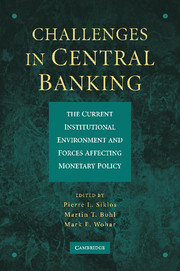 Challenges in Central Banking
Challenges in Central Banking Published online by Cambridge University Press: 06 December 2010
Abstract
Recent research in monetary policy emphasizes the endogenous nature of the central bankers' decision process, shifting focus toward institutional structure and “incentive” constraints. Much of this work attempts to mitigate time inconsistency, credibility, and political problems that emerge from this agenda. In this chapter, we present the principal-agent approach to central banking and discuss its relationship to the other institutional designs. We also provide an extensive review of the existing literature on central bank contracts and discuss the related equivalence propositions that emerge.
Introduction
In this chapter, we present the view that monetary policy delegation reflects a principal-agent problem between government (society) and the central bank. The principal (government) delegates monetary policy implementation to the agent (central bank). In the 1960s and 1970s, attempts by government to exploit the apparent trade-off between inflation and unemployment along the short-run Phillips curve led to the idea of the time inconsistency of monetary policy (Kydland and Prescott 1977; Calvo 1978). The resulting inflationary bias in the implementation of monetary policy prompted a search for the “holy grail of monetary policy.”
More recent practical and theoretical developments shift the focus away from the assumption of an inflationary bias. Monetary policy in the standard dynamic stochastic general equilibrium (DSGE) models can typically achieve full stabilization, but nevertheless the absence of an inflationary bias does not suffice to eliminate issues of monetary policy credibility. A vast literature addresses issues of monetary policy design.
To save this book to your Kindle, first ensure no-reply@cambridge.org is added to your Approved Personal Document E-mail List under your Personal Document Settings on the Manage Your Content and Devices page of your Amazon account. Then enter the ‘name’ part of your Kindle email address below. Find out more about saving to your Kindle.
Note you can select to save to either the @free.kindle.com or @kindle.com variations. ‘@free.kindle.com’ emails are free but can only be saved to your device when it is connected to wi-fi. ‘@kindle.com’ emails can be delivered even when you are not connected to wi-fi, but note that service fees apply.
Find out more about the Kindle Personal Document Service.
To save content items to your account, please confirm that you agree to abide by our usage policies. If this is the first time you use this feature, you will be asked to authorise Cambridge Core to connect with your account. Find out more about saving content to Dropbox.
To save content items to your account, please confirm that you agree to abide by our usage policies. If this is the first time you use this feature, you will be asked to authorise Cambridge Core to connect with your account. Find out more about saving content to Google Drive.